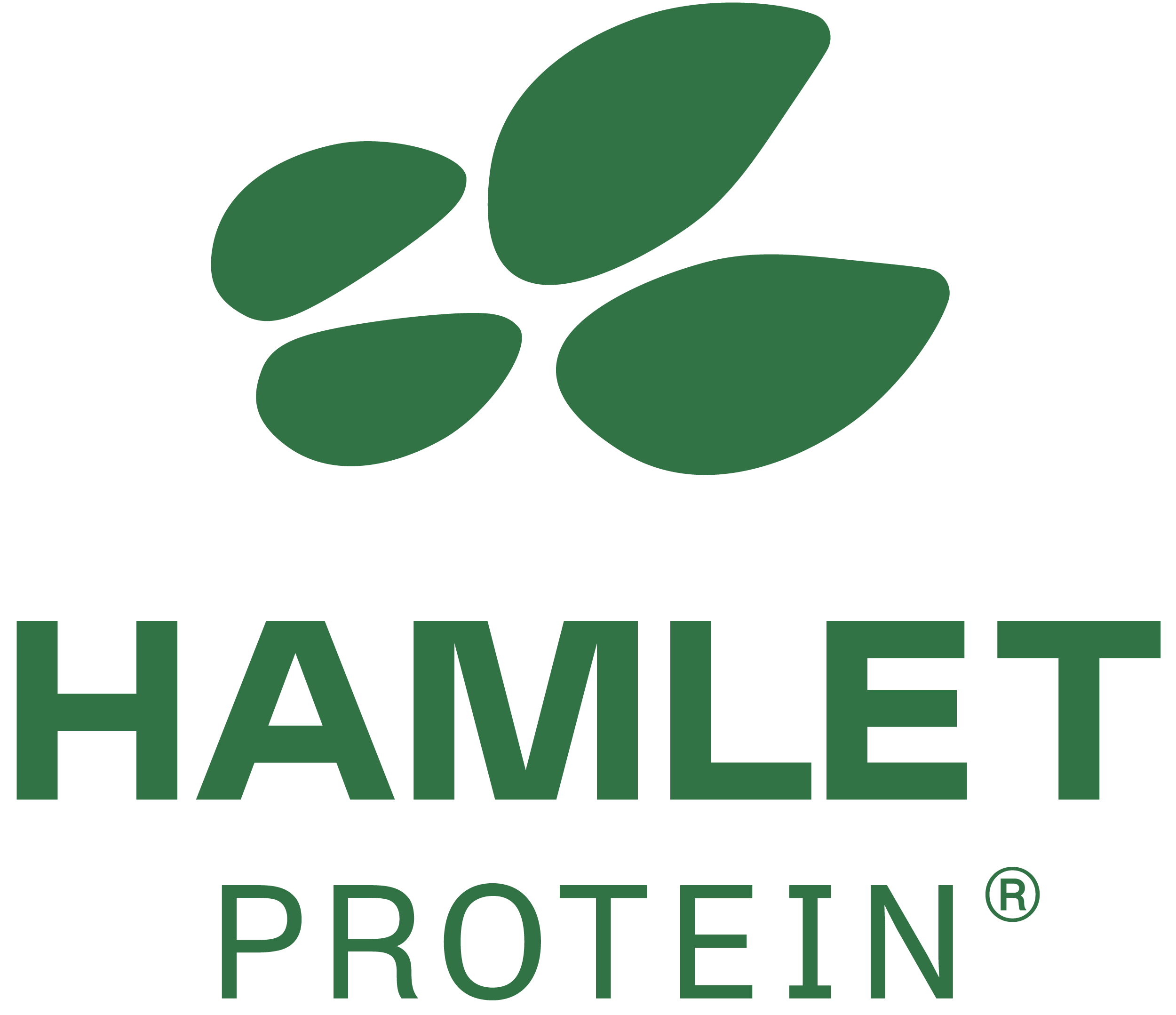



Protein kinetics in vivo: The benefits of fast protein in diets of weaned pigs
Improves growth performance, overcomes low crude protein levels, and reduces nitrogen excretionEveryone that has followed our recent articles and posts know that Hamlet Protein has been talking about protein kinetics for quite a while now. At Hamlet Protein we are passionate about driving research on protein digestion, so our customers can be frontrunners in their industry.
Just to recapture what all that fuzz is about; protein kinetics refers to dynamics of the digestion and absorption of protein and most importantly how fast this happens. The faster a protein source is digested and absorbed the faster it becomes available for the animals. We know from recent scientific findings that the biological value (how much of the protein can be used for deposition) is higher for faster proteins which means less protein is wasted. So, faster proteins are also better for the environment as less nitrogen is excreted.
Over the last two years we have conducted trials at Hamlet Protein to find out which protein ingredients classify as fast, and which classify as slow. The results of these studies were rather surprising. Some protein ingredients generally considered as highly digestible were rather slow when it came to protein kinetics. And we also discovered that Hamlet Protein produces the fastest vegetable protein source; HP300. The results of this research have been published recently at the ASAS-CSAS-WSASAS 2023 meeting in the USA.¹
Now, we were ready to go to real practice to see whether weaned pigs on a diet with fast protein outperformed pigs on a diet with slow protein. To test this we formulated 4 diets, using as the differentiating protein source either HP300 (fastest vegetable protein) or a soy protein concentrate (SPC), that was previously tested as very slow (Table 1, Figure 1A). The 4 diets differed in protein source but also in protein level (16 vs 19%), so creating SLOW-LOW, SLOW-HIGH, FAST-LOW and FAST-HIGH (see Table 1). All diets were supplemented with synthetic amino acids to meet the requirements.

Next step in our process was to check whether the inclusion of either HP300 or SPC was enough to create protein kinetics differences in the final diets. And the results were very good. There was a 45% difference in protein digestion speed between SLOW-LOW and FAST-LOW and a 63% difference in digestion speed between SLOW-HIGH and FAST-HIGH which was sufficient to provide digestion speed contrast in the in-vivo trial (Figure 1).
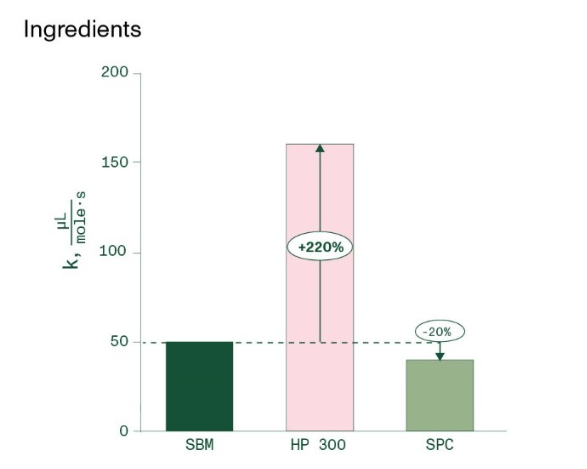
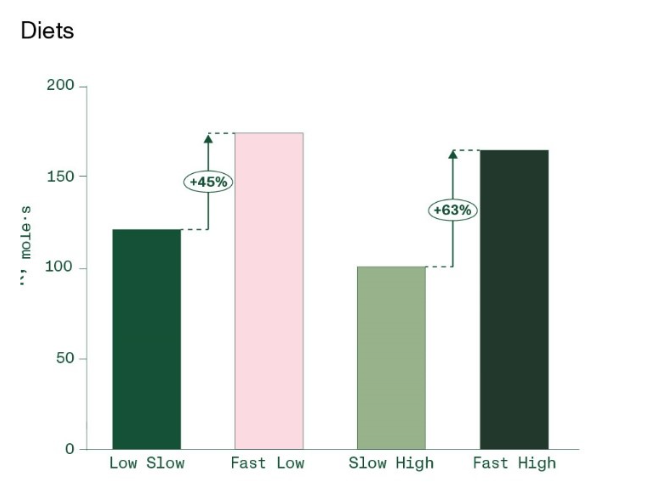
For the following in-vivo test 256 weaned intact male piglets (YxL; age 28d at 7.3 kg) were allocated to one of the four diets based on weight. When analyzing the data after a trial duration of 28 days we saw that there was no interaction between protein levels and protein digestion speeds for growth performance. Feed intake did not differ for FAST or SLOW for D0-14 and there was only a numerical difference in FCR between FAST and SLOW (1.26 vs 1.30, D0-D14 and 1.31 vs 1.32 for D0-28, respectively; P>0.05). There was, however, a strong effect of protein speed noticeable in the growth performance results. Total weight gain was positively influenced by digestion speed with higher gains for FAST 11.1 ± 2.0 kg compared to SLOW 9.8 ± 2.1 kg, respectively (P<0.05)(Table 2). Bodyweight on D28 was higher for pigs fed FAST diets compared to SLOW (18.5 ± 3.1 vs. 17.0 ± 2.6 kg; P<0.05) (Table 2).

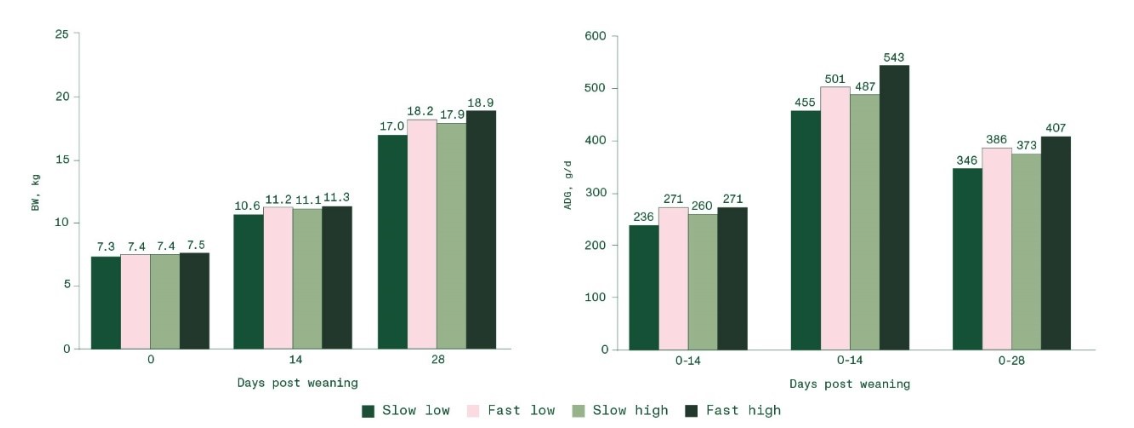
What was very interesting to see when looking at the individual diets (Figure 2A&B) is that FAST-LOW numerically outperformed the growth performance of SLOW-HIGH. Even at lower protein levels (16% vs 19% CP) the FAST-LOW showed higher BW and better ADG. So, this means that using a fast protein source one can lower crude protein levels without losing performance. This is probably related to a better synchronization in absorption with the supplemented synthetic amino acids in the diet. Zhang et al., 2022 showed that the better the synchronization in absorption of total amino acids is the higher the nitrogen deposition rate and the higher the apparent biological value of the protein source is. This indicates that faster protein is better utilized than slow protein. This was confirmed by lower nitrogen levels in feces for FAST diets. Average nitrogen levels in feces from D14-28 tended to be lower for FAST compared to SLOW (326 vs 343 mg/g DM feces/CP intake, P=0.1). On D28 FAST-LOW had less nitrogen (mg/g)/DM feces/CP intake than SLOW-LOW (303 mg vs 390 mg, P<0.05, respectively). So, from fast protein less nitrogen is wasted. Therefore, protein kinetics are more indicative of feed efficiency and protein deposition than the digestibility coefficient of the protein ingredient.
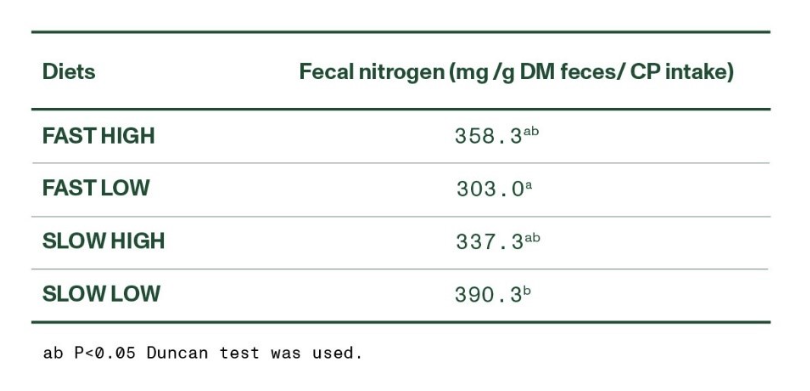

The results of this study indicate that differences in in-vitro protein kinetics between protein ingredients created differences in protein kinetics in final diets which are related to the in-vivo performance of weaned pigs on these diets. Pigs on FAST protein showed better growth performance than pigs on SLOW protein. The use of FAST protein allows for the reduction of CP levels without losing performance. This argues in favor of a better protein efficiency for FAST protein. A finding that was supported by lower nitrogen excretions for FAST protein. It is therefore safe to say that not only (young) animals have a requirement for fast protein from a physiological point of view but also nutritionist have a requirement of fast protein order to optimize the use of synthetic amino acids in the diets and to meet the requirements regarding total nitrogen excretion reduction.
Vegetable plasma
From the findings of this study, we conclude that (young) animals have a requirement in fast protein as this enables them to use more of the protein for deposition. Furthermore, when supplementing diets with synthetic amino acids, the absorption of all the amino acids from the diet need to be synchronized with these synthetic amino acids not to lose efficiency. A fast protein source allows for good synchronization in the absorption of amino acids. Hamlet Protein produces the fastest vegetable protein source which is also almost free of the most important anti-nutritional factors. Studies show that the Hamlet Protein portfolio outperforms all vegetable protein sources when it comes to kinetics and is also on par with the animal proteins like fish meal and blood plasma. We therefore propose a new positioning and reappreciation of our flagship product HP300 as the only vegetable plasma on the market.
| References | ||||
|---|---|---|---|---|
| Bible et al., (2023). | ||||
| Zhang et al., (2022) | ||||





